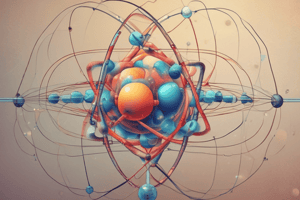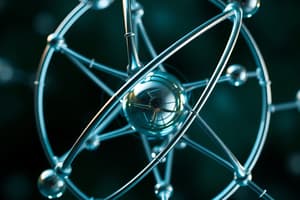Podcast
Questions and Answers
What is the smallest particle that all matter is made of?
What is the smallest particle that all matter is made of?
- Molecule
- Compound
- Atom (correct)
- Element
What is the charge of electrons in an atom?
What is the charge of electrons in an atom?
- Negative (correct)
- Positive
- Neutral
- It varies
What is the maximum capacity of the 2nd electron shell?
What is the maximum capacity of the 2nd electron shell?
- 18
- 32
- 8 (correct)
- 2
What is the term for the number of protons in the nucleus of an atom?
What is the term for the number of protons in the nucleus of an atom?
What is the term for two or more different types of atoms bonded together?
What is the term for two or more different types of atoms bonded together?
What is the symbol for silver?
What is the symbol for silver?
What is the purpose of the electron shells in an atom?
What is the purpose of the electron shells in an atom?
What is a molecule composed of?
What is a molecule composed of?
What is the term for a substance composed of only one type of atom?
What is the term for a substance composed of only one type of atom?
What is the significance of the atomic number?
What is the significance of the atomic number?
What is the purpose of a chemical formula?
What is the purpose of a chemical formula?
What is the difference between a molecule of an element and a molecule of a compound?
What is the difference between a molecule of an element and a molecule of a compound?
What is the nucleus of an atom composed of?
What is the nucleus of an atom composed of?
What are the positively charged subatomic particles in an atom?
What are the positively charged subatomic particles in an atom?
What determines the identity of an element?
What determines the identity of an element?
What is the maximum capacity of the 1st electron shell?
What is the maximum capacity of the 1st electron shell?
What is a molecule of CO2 an example of?
What is a molecule of CO2 an example of?
What is the purpose of the Periodic Table?
What is the purpose of the Periodic Table?
What is the formula for a molecule of water?
What is the formula for a molecule of water?
What is the charge of neutrons in an atom?
What is the charge of neutrons in an atom?
Flashcards are hidden until you start studying
Study Notes
Chemistry Basics
- Atoms are the smallest particles that make up all matter, consisting of a nucleus (center) and electron shells (orbiting the nucleus).
Atomic Structure
- Atoms contain three subatomic particles: protons (positively charged), neutrons (neutral), and electrons (negatively charged).
- Protons and neutrons are found in the nucleus, while electrons orbit the nucleus in electron shells.
Electron Shells
- Electron shells have a maximum electron capacity: 1st shell = 2, 2nd shell = 8, 3rd shell = 18 (stable at 8), 4th shell = 32.
Elements
- Elements consist of the same type of atom and are the building blocks of all substances.
- Elements are listed in the Periodic Table in order of their atomic number (number of protons in the nucleus).
- Each element has its own symbol, such as Hydrogen (H), Carbon (C), and Nitrogen (N).
Molecules
- A molecule is formed when two or more atoms are joined together by a chemical bond.
- If the atoms are the same type, it's a molecule of an element (e.g., O2).
- If the atoms are different, it's a molecule of a compound (e.g., CO2).
Compounds
- A compound is formed when two or more different types of atoms are bonded together.
- Common examples of compounds include water (H2O), carbon dioxide (CO2), methane (CH4), and glucose (C6H12O6).
- The formula of a compound indicates the number of atoms from each element present.
Studying That Suits You
Use AI to generate personalized quizzes and flashcards to suit your learning preferences.




